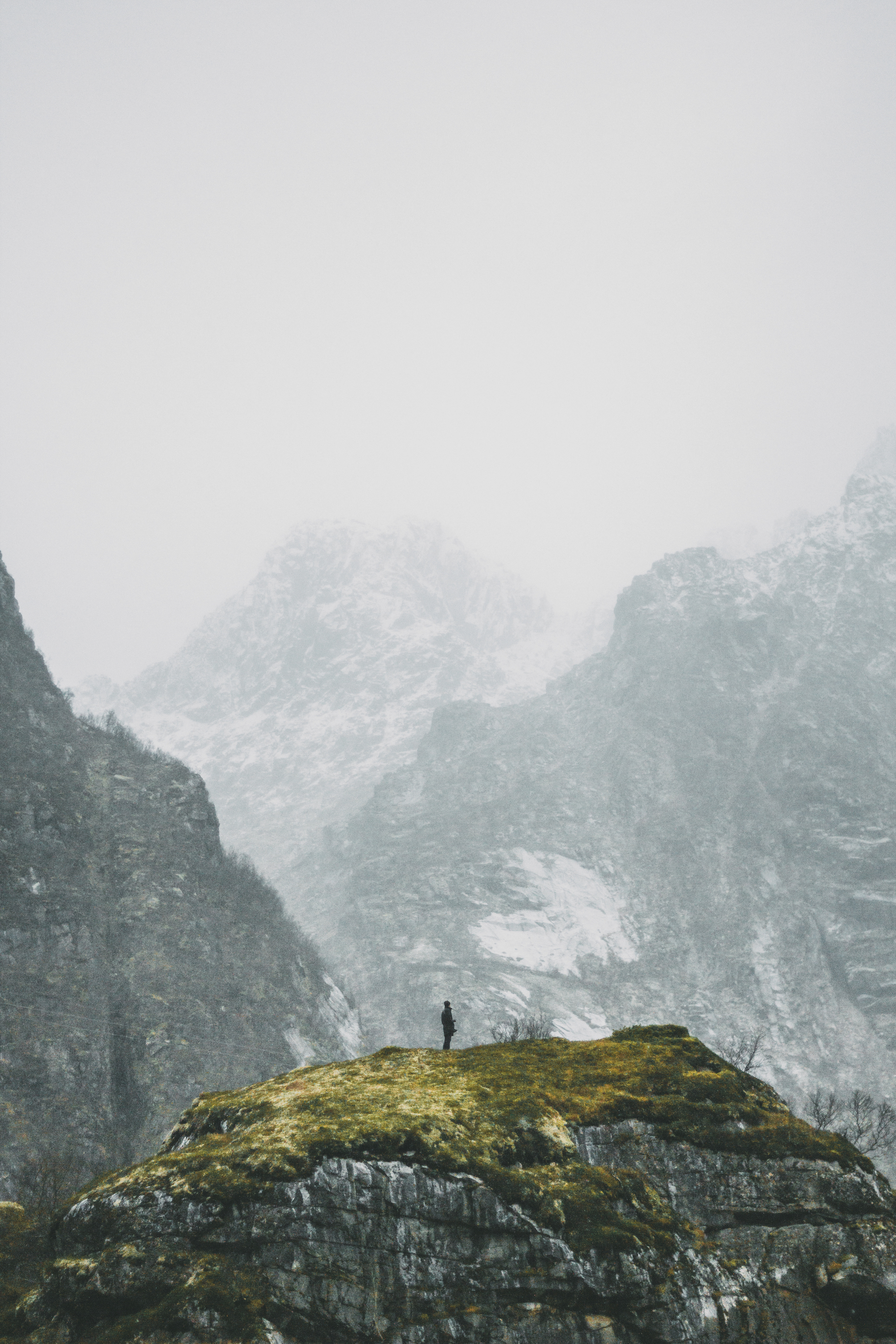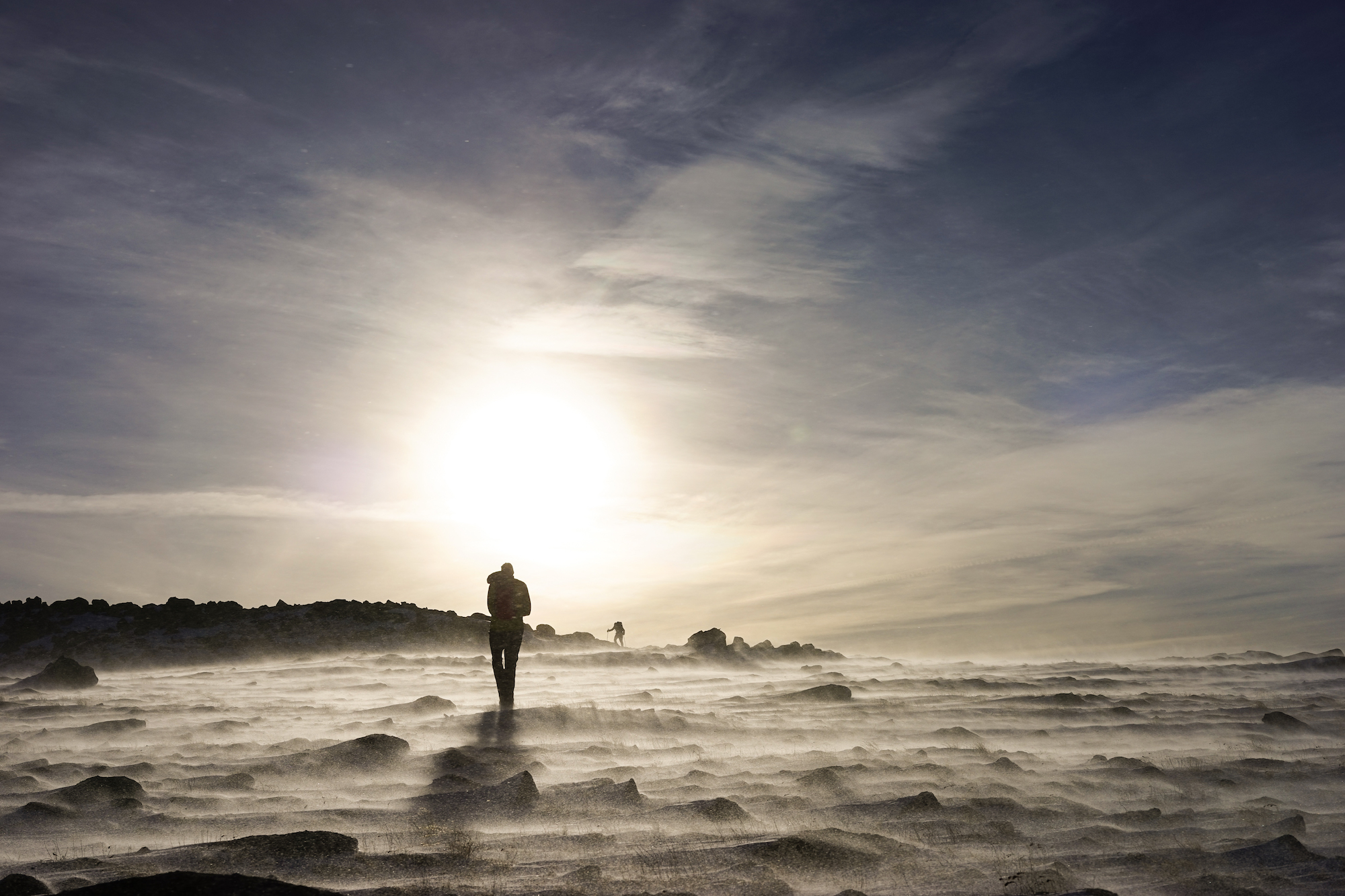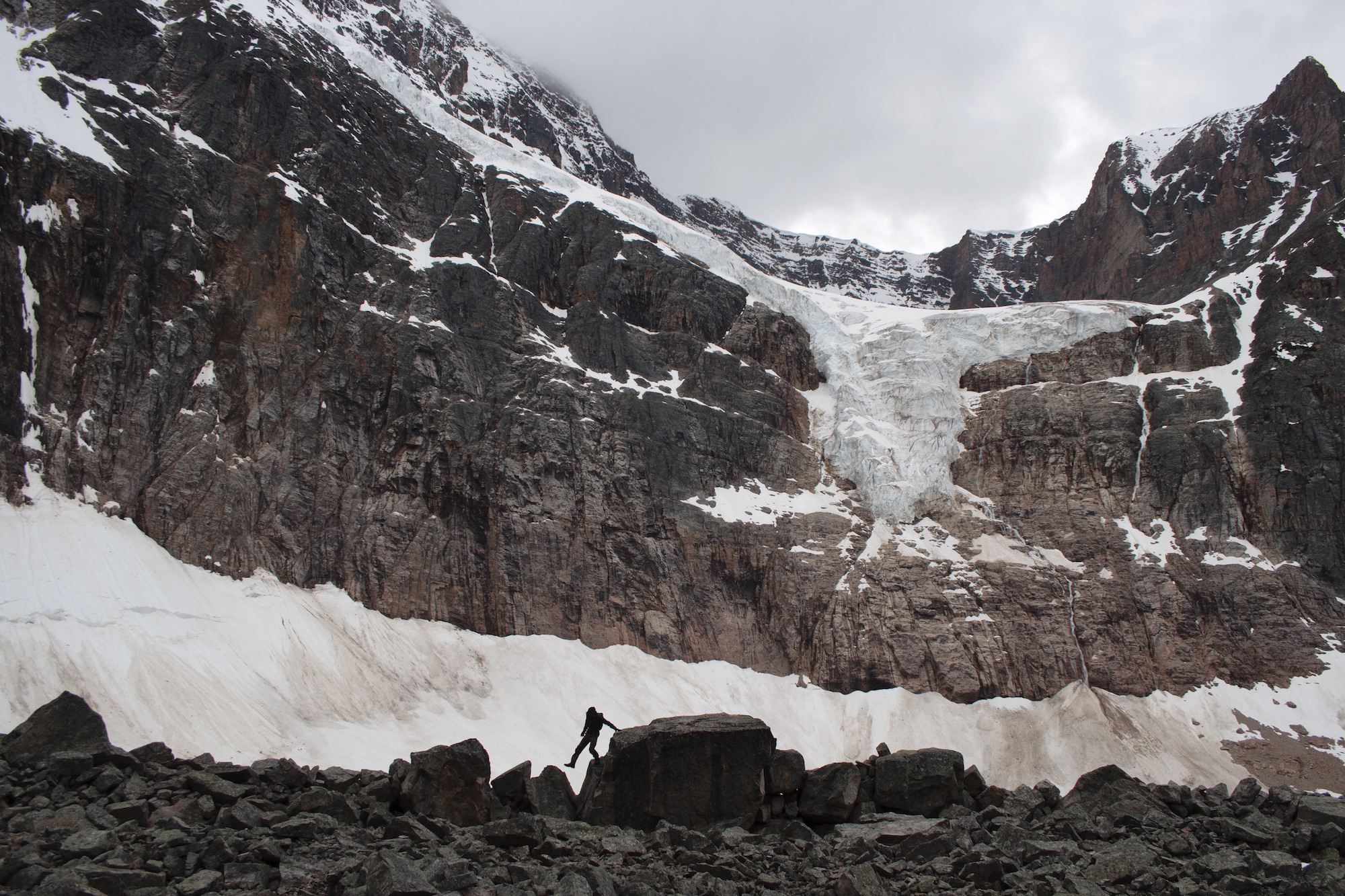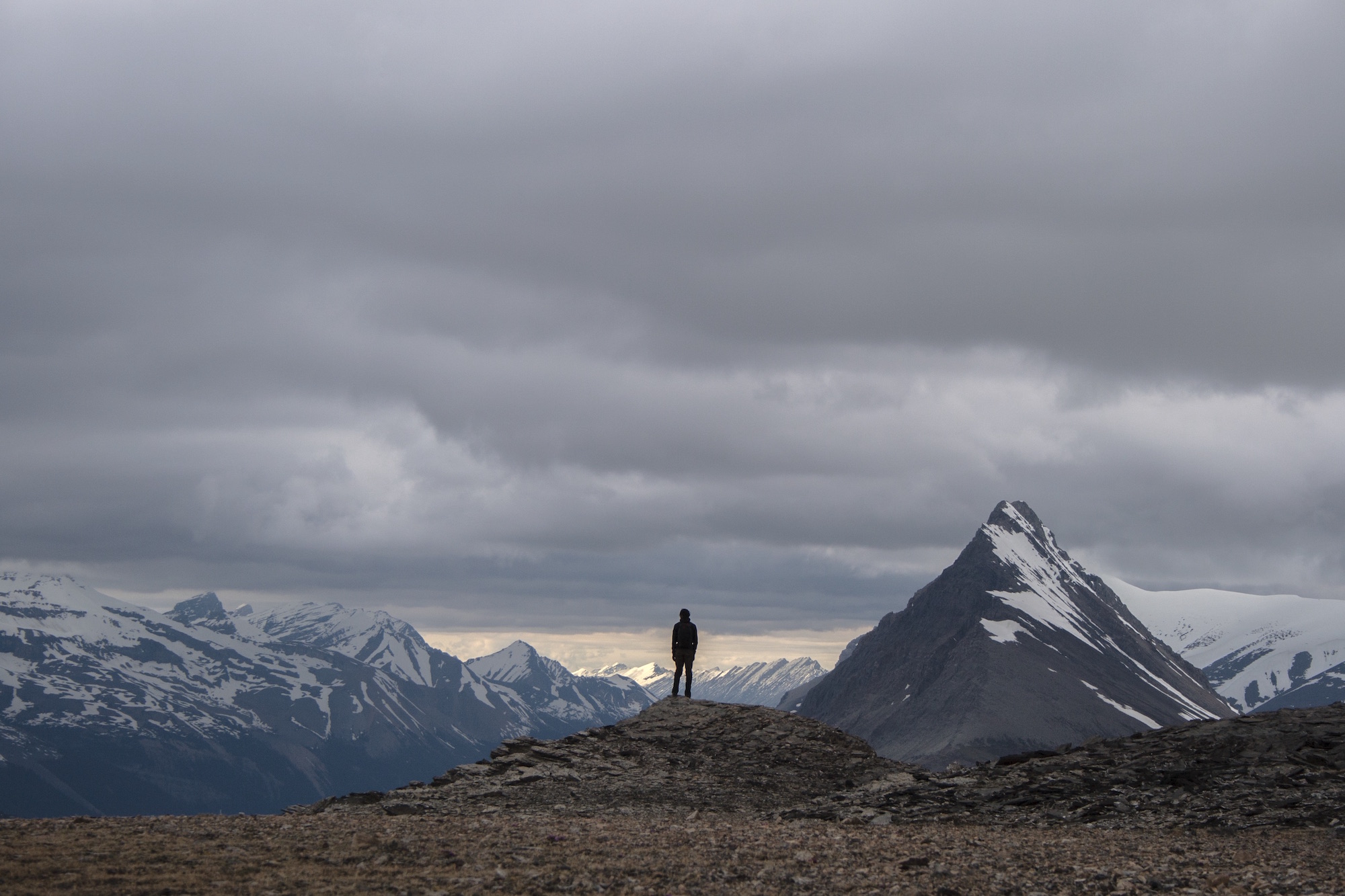In Praise of Walks and Wilderness
Writer and poet Haley Littleton seeks out fragile moments of being that exist in nature—on trails, summits, and cliffs. Climbing mountains and wandering forests, we feel intoxicatingly happy and at once meek in our undefended bodies provoked toward the verge of physical capacity. The alpenglow illuminates the tips of the adjacent ridge as we crest the saddle of the trail. We have settled into our gait and into silence, elongating our steps to reach a lookout point from the gray, shifting scree field. A moun- tain goat follows our path up the rocky steps, and we pause at the top for a breath, a view, and water. This is a moment when I feel extraordinary happiness. It doesn't matter that in our ascent of Mount Sherman, we missed the peak three times, ascending three different 13,000-foot (ca. 3962-meter) peaks instead, or that our planned three-hour hike turned into six hours. I was content to crouch down and stare at the mauve and olive-colored succulent plants that lined the ascent to the peak and wonder what species they were. I was not concerned when or how we would reach the eventual summit.

When critic and poet Charles Olson spoke of poetry, he spoke of walking and of breathing. He spoke of measuring the line of the poem to the rhythm of breath. This “projective verse” called the whole body of the poet into measure. This is a form of “frolic architecture,” as Olson calls it, which one might consider artful kinesiology: to trace out lyric and language with body and space and mountain. By being a participant in nature, one is able to listen and then create from this space. We’ve all had those moments when we step out into the fresh mountain air: breathe in, breathe out, recenter.
It’s like Moab this past March: While back home was filled with uncertainties, rifts, and unpleasant memories, to stand upon the plateau and look across at the deep tannish reds, browns, and yellowish greens of Upheaval Dome—cuts made thousands of years ago—even in the sweltering heat and the sweat of the hike, I felt a peace I have not found elsewhere. I stood and thought of Edward Abbey’s words in the preface of his book Desert Solitaire:
Benedicto: May your trails be crooked, winding, lonesome, dangerous, leading to the most amazing view. May your mountains rise into and above the clouds. May your rivers flow without end, meandering through pastoral valleys tinkling with bells, past temples and castles and poets’ towers into a dark primeval forest where tigers belch and monkeys howl, through miasmal and mysterious swamps and down into a desert of red rock, blue mesas, domes and pinnacles and grottos of endless stone, and down again into a deep vast ancient unknown chasm where bars of sunlight blaze on profiled cliffs, where deer walk across the white sand beaches, where storms come and go as lightning clangs upon the high crags, where something strange and more beautiful and more full of wonder than your deepest dreams waits for you beyond that next turning of the canyon walls.
More full of wonder than your deepest dreams, indeed. I kept looking over to my friend, continually proclaiming: “I can’t believe how happy I am here.” I understood Abbey’s fierce ecological devotion to the place. Preservation begins with appreciation; it begins with experiential love. “Earn your turns,” a friend always calls out, strapping his skins to his skis and hoisting his body up the incline. Another pal takes off to the mountains when big life decisions loom in front of him: “It’s the only place quiet and still enough to think.” One hikes fourteeners to prove to himself that his body is capable of more than he believes and that what others say about him is not the whole story. One of my best friends may have hated the peak I dragged her up during our climb, but afterward she turned to me and sighed, “I’ve never felt more alive or more in love with my body.” Once, on a backpacking trip with high school senior girls, one turned excitedly to me and said, “I haven’t thought badly about my body this whole trip!” I think of my skis hanging over the ledge of Blue Sky Basin, my toes hurting like hell, my legs are tingling and frozen, and my flight-or-fight mode tells me that the drop in isn’t worth the potential outcome of pain. But when I look up at the snow-crested ridges against the deepest blue backdrop I’ve ever seen, I push on and fire up my legs, reminding myself that this view is worth the discomfort it takes to reach it.

In an age that saw the rise of print reproduction, philosopher Walter Benjamin spoke of original art as containing an “aura” that reflects its presence in time and space: the sentiment contained within and the value connected to an experience with art. It's a sense that mirrors the way we sometimes want to touch a piece of artwork on the walls to simply feel it, as if to be a part of it. This same aura exists in nature: “If, while resting on a summer afternoon, you follow with your eyes a mountain range on the horizon or a branch which casts its shadow over you, you experience the aura of those mountains, of that branch,” says Benjamin. Sculptor Andrew Goldsworthy embodies this idea of “nature aura” in his entirely nature-derived pieces made from branches carefully arranged, leaves woven together, stacks of rocks or ice melted and refashioned, all of which rest entirely upon impermanence. Happen upon his works before they are gone.
If human sense perception changes with historical circumstance, what does the recent technological boom and rise of virtual realities do to our perception of nature? Why does climbing a mountain matter if we can see the same view on Instagram? Why does visiting a location matter if Google Earth offers us the same view from the sofa? It seems this sense of feeling is disappearing as the search for experience is constantly digitized and commercialized. We pry a thing from its shell and market the hell out of it. We want things to be more accessible, to be easy to get to, so we pave roads on the tops of fourteeners and take all risk out of our outdoor adventures. Or, we consistently see pictures on social media of beautiful scenes and stay content to remain inside. But there’s something about the body that matters. There’s something about being there that we miss.
Ecologists speak now of a need for “deep ecology,” not just an understanding of ecological issues and piecemeal scientific responses, but an overhaul of our philosophical understanding of nature. Instead of viewing mankind as the overlord of nature, it’s about revisiting the idea that a give-and-take relationship exists between the human and the nonhuman, a relationship that thrives on mutual respect and appreciation. To develop this sort of appreciation for nature and the nonhuman, it matters that we actually experience it. For many ecological thinkers, walking among mountains can be the first step in healing a false split between body and mind. The grief at the destruction of a beautiful building, the ecstatic joy of a sunrise in the mountains—these moments stem from this unification of the two.
“For many ecological thinkers, walking among mountains can be the first step in healing a false split between body and mind.”
Fragile moments of being that exist in nature
It’s a question of place versus nonplace. In The Conscience of the Eye: The Design and Social Life of Cities, Richard Sennett points to the peculiarity of the American sense of place: “that you are nowhere when you are alone with yourself.” Sennett speaks of cities as nonplaces, in which the person among the crowd slips into oblivion, only existing inside him- or herself. Other nonplaces look like the drudgery of terminals or waiting lines or places where all eyes are glued to phones. The buildings are uniform, and the faces blur together to create a boring conglomerate of civilization. If to be alone in a city is to be nowhere, the antithesis must be that to be alone in nature is to be everywhere. Nature is a place characterized by its “thisness,” as Gerard Manley Hopkins describes it—a place to enter into that is palpable with its own essence and feeling.
But as we lose our connection to place, as virtual reality turns here into nowhere, we lose our ability to narrate our experiences of nature. Recently, nature writer Robert Macfarlane pointed out that in the Oxford Junior Dictionary, the virtual and indoor are replacing the outdoor and natural, making them blasé. When we lose the language to describe our connection to landscape and place, we lose the actual connection to these things and the value decreases, separating us from the natural. According to Macfarlane, we have always been “name-callers, christeners,” always seeking language that registers the dramas of landscape, and the environmental movement must begin with a reawakening of natural wonder–inspired language.
Perhaps the point of all of this is to work to develop more refined attention, an ability to seek out and perceive fragile moments of being that exist in nature. We must pay attention to our breath and our bodies. Wendell Berry, a prophet of the natural, writes that to pay attention is to “stretch toward” a subject in aspiration, to come into its presence. To pay attention to mountains, we must come beneath them and reach out toward them.

To walk is to perceive
How do we begin? By wandering within the wilderness. Rebecca Solnit’s book on walking comes to mind: “Walking is one way of maintaining a bulwark against this erosion of the mind, the body, the landscape, and the city, and every walker is a guard on patrol to protect the ineffable.” While people today live in disconnected interiors, on foot in wilderness the whole world is connected to the individual. This form of investing in a place gives back; memories become seeded into places, giving them meaning and associations both in the body and the mind. Walking may take much longer, but this slowing down opens one up to new details, new possibilities.
Brian Teare is one of my favorite modern poets because his poetry is centered upon Charles Olson’s projective verse and on walking. All his works contain physical coordinates, anchoring each work of art to the place that inspired it. The land becomes the location, subject, and meaning to the thoughts and feelings that Teare wants to convey. As we enter into a field or crest the ridge of a mountain, we perceive the sight of the landscape and experience our bodies within it. We feel the wind and touch the dirt; we see the edges and diversity of the landscape. Perhaps we have hiked a far distance to reach this place and feel the journey within the body. Teare says in one of my favorite poems, “Atlas Peak”:
we have to hold it instead
in our heads & hands
which would seem impossible
except for how we remember
the trail in our feet, calves,
& thighs, our lungs’ thrust
upward; our eyes, which scan
trailside bracken for flowers;
& our minds, which recall
their names as best they can
Sitting on the side of Mount Massive, on the verge of tears, I felt utterly defeated. Our group took the shorter route, which had resulted in thousands of feet of incline in just a few miles, and my lungs, riddled with occasional asthma, were rejecting the task before them. It felt as if all the rocks in the boulder field had been placed upon my chest. My mind went to the thought of wilderness: Was it freedom or a curse? What would happen to me if something went wrong up here? Risk and freedom hold hands with each other in the mountains. After a long break, a few puffs of albuterol, water, and grit, I pulled myself up the final ascent and false summits along the ridge. I have been most thankful for my body when I have realized how beautifully fragile and simultaneously capable it is. On the summit, as we watched thin wispy waves of clouds weave into each other and rise around us, the mountain gently reminded me that I am not in control. I am not all-powerful, and nature’s lesson to me that morning was to respect its wildness.
"Risk and freedom hold hands with each other in the mountains."

As in all things, essentialism should be avoided. We live in a world that tends toward black-and-white perspectives, and when one praises the wilderness, those remarks can devolve into Luddite sentiments that are antipeople, antitechnological, and antihistorical. This solves nothing. Advancements in civilization are welcome and beautiful; technology has connected us in unprecedented ways. But as with anything, balance is key. We need the possibility of escape from civilization, even if we never indulge it. We need it to exist as an antithesis to the stresses of modern society. We need wilderness to serve as a place to realize that we exist in a tenuous balance with the world around us. All the political and societal struggles matter little if we have no environment to live in. In a world of utilitarian decision-making, a walk in the woods may be considered frivolous and useless, but it is necessary. The choice to preserve or to dominate is ours. But before deciding, perhaps one should first wander among the mountains. △
This essay is accompanied by the poem "Post Tenebras Lux" by Haley Littleton.
